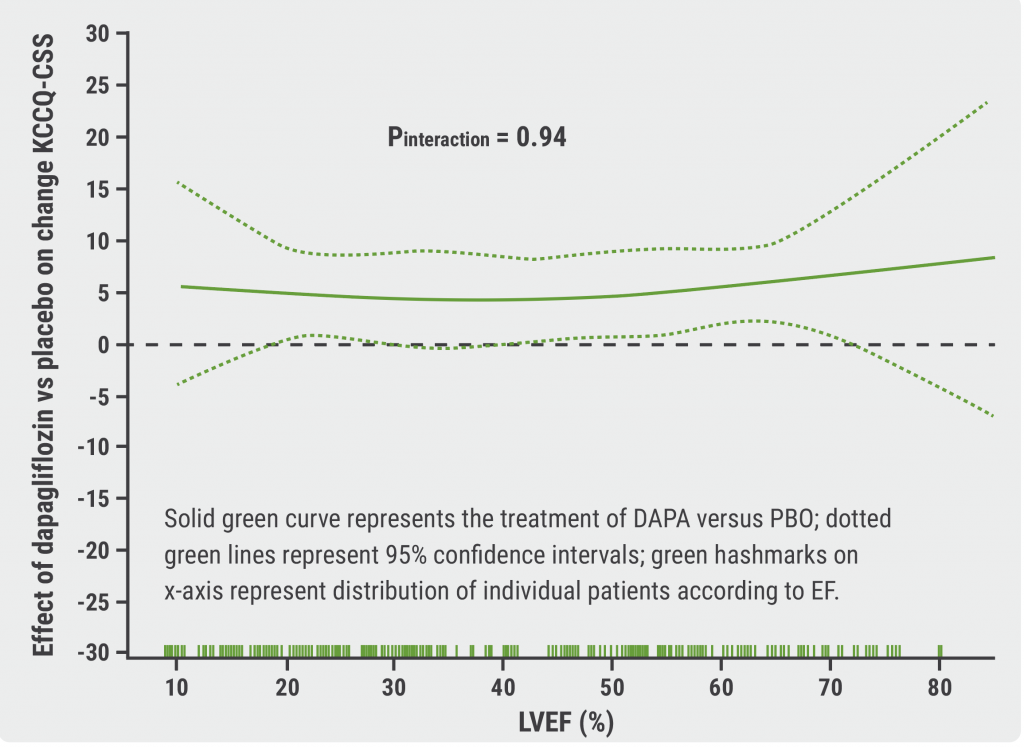https://doi.org/10.55788/58ad6a61
SELECT (NCT03574597) was a multicentre, double-blind, placebo-controlled, event-driven, superiority phase 3 trial evaluating the effect on MACE of semaglutide [1]. The 17,604 randomised participants with cardiovascular disease (CVD) and a BMI ≥27 kg/m², but no diabetes, were randomised to subcutaneous semaglutide 2 mg or 4 mg once a week or placebo. After a mean follow-up of 40 months, semaglutide reduced the relative risk of MACE by 20%. A pre-specified analysis of this study looked at time to first MACE (HF hospitalisation, urgent HF visit, or CV death), CV mortality, and total mortality in participants with HF (n=4,286) and without HF (n=13,314) [2].
The results were presented by Prof. John Deanfield (University College London, UK). The effect of semaglutide on the incidence of MACE did not differ between participants with HF (HR 0.72; 95% CI 0.60–0.87) and those without HF (HR 0.84; 95% CI 0.74–0.97; Pinteraction=0.1934). The positive effect of semaglutide on the incidence of MACE was consistent in subgroups stratified by gender, age, and baseline characteristics such as BMI, NYHA class, and HbA1c level.
A consistent benefit was also observed after stratification by HF subtype: HR 0.65 (95% CI 0.49–0.87) for participants with HF with reduced ejection fraction (HfrEF; n=1,347) and 0.69 (95% CI 0.51–0.91) for those with preserved ejection fraction (HFpEF; n=2,273) (Pinteraction=0.82). There was no significant interaction between HF status at baseline and treatment efficacy for the composite of HF hospitalisation, urgent visit for HF, or cardiovascular death: semaglutide was beneficial in patients with HF (HR 0.79; 95% CI 0.64–0.98), and in patients without HF (HR 0.85; 95% CI 0.68–1.06; Pinteraction=0.64). The benefit for the composite of HF hospitalisation, urgent visits for HF, or cardiovascular death was consistent between HF subtypes. In addition, the effect for all-cause mortality was consistent between participants with HF (HR 0.81; 95% CI 0.66–1.00) and those without HF (HR 0.81; 95% CI 0.67–0.97; Pinteraction=0.9797) nor between participants with HFrEF compared with HFpEF. The safety profile of semaglutide was similar in participants with or without HF and between HF subtypes.
“The efficacy data combined with a reassuring safety profile support the use of semaglutide to improve CV outcomes in a broad population of patients with atherosclerotic CVD and overweight or obesity, regardless of history of HF or HF subtype,” concluded Prof. Deanfield.
- Lincoff AM, et al. N Engl J Med 2023;389:2221–32.
- Deanfield J, et al. Semaglutide and cardiovascular outcomes in patients with overweight or obesity and heart failure: A pre-specified analysis from the SELECT trial. Late breaking clinical trials II, Heart Failure 2024, 11–14 May, Lisbon, Portugal.
Copyright ©2024 Medicom Medical Publishers
Posted on
Previous Article
« SEQUOIA-HCM: Aficamten demonstrates clinical efficacy in obstructive HCM Next Article
Biologics in psoriatic arthritis: where we are and where we are headed »
« SEQUOIA-HCM: Aficamten demonstrates clinical efficacy in obstructive HCM Next Article
Biologics in psoriatic arthritis: where we are and where we are headed »
Table of Contents: HFA 2024
Featured articles
Meet the Trialist: Innovating cardiac monitoring with MONITOR-HF
Trials: Pharmacology
Effects of semaglutide on MACE irrespective of HF status
SEQUOIA-HCM: Aficamten demonstrates clinical efficacy in obstructive HCM
ARIES-HM3 trial: Subgroup analysis in patients with prior need for aspirin
Three diuretic regimens compared in the DEA-HF study
Adding a mineralocorticoid receptor modulator in heart failure with CKD
SGLT2 Inhibitors
Empagliflozin did not reduce mortality for HF after MI regardless of T2D status
SGLT2 inhibitors decrease atrial fibrillation risk in patients with HFrEF
SGLT2 inhibition: Major and early impact on heart failure hospitalisation risk
Trials: Other
Individualised diuretic titration in acute HF without a physician
Intravenous iron deficiency treatment improves exercise capacity in patients with HFpEF
CD34+ stem cells promote reverse cardiac remodelling after acute MI
Registries
Sex-specific outcomes and resource utilisation after HF hospitalisation
Application of guideline-directed medical therapy in patients with HFrEF in the Netherlands
Devices
PAP-guided management system appears safe in patients with HF
Delivery of CRT guided by non-invasive anatomy assessment
RELIEVE-ing HFrEF with interatrial shunting
Miscellaneous
Algorithm-based remote patient monitoring was associated with lower mortality in a retrospective cohort study
High mortality and morbidity in suspected de novo HF in outpatient care
Bio-ADM as a marker for congestion in patients hospitalised for acute HF
Hypertonic saline not effective in ambulatory patients with heart failure?
No effect of low-dose carperitide on mortality or hospitalisation in acute HF
Related Articles

July 28, 2022
Dapagliflozin performs consistently across LVEF in HF
© 2024 Medicom Medical Publishers. All rights reserved. Terms and Conditions | Privacy Policy
HEAD OFFICE
Laarderhoogtweg 25
1101 EB Amsterdam
The Netherlands
T: +31 85 4012 560
E: publishers@medicom-publishers.com

